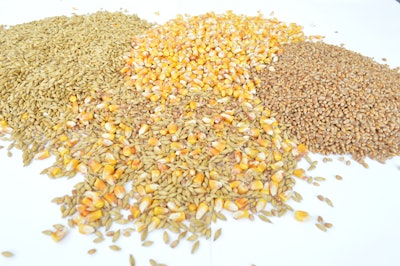
The U.S. production forecasts in this report are based on conditions as of August 1. Any potential impacts from severe weather that occurred after August 1 will be reflected in future reports.
WHEAT: The outlook for 2020/21 U.S. wheat this month is for increased production offset by lower imports, higher exports, and lower ending stocks. U.S. wheat production is raised 14 million bushels to 1,838 million as increased Hard Red Spring (HRS) and Durum production more than offsets lower winter wheat production as indicated by the NASS August 12 Crop Production report.
Imports are lowered 10 million bushels this month to 130 million on the larger HRS supplies. Estimated food use for 2019/20 is lowered fractionally to 962 million bushels, based on the latest NASS Flour Milling Products report. Food use for the 2020/21 market year is lowered 4 million bushels to 960 million as food consumed away from home is expected to remain lower than last year due to the impact of COVID-19.
Projected 2020/21 exports are raised 25 million bushels to 975 million on lower production for several key competitors, most notably the EU. With offsetting supply changes and increased use, ending stocks are lowered 17 million bushels to 925 million. If realized, these will be the lowest wheat ending stocks in 6 years. However, the season-average farm price is decreased $0.10 per bushel to $4.50 on lower U.S. corn prices and reduced wheat price expectations for the remainder of the market year. Foreign 2020/21 wheat production is lowered 3.7 million tons led by a 4.0-million-ton reduction for the EU, and 1.0-million-ton reductions each for Kazakhstan and Turkey. These changes are partially offset by a 1.5-million-ton production increase for Russia and a 1.1-million-ton increase for Brazil.
The production changes are based on updated harvest results and government estimates. Global beginning stocks are raised 3.8 million tons, reflecting several mostly offsetting changes as well as a 3.5 million ton increase for the EU, which is based on multi-year revisions to both use and stocks. Foreign consumption is lowered 1.3 million tons, led by a 1.0- million-ton reduction for EU feed and residual use based on the smaller crop.
Global exports are lowered fractionally with several offsetting changes including a 1.5-million-ton cut for the EU, and a 0.8-million-ton reduction for Kazakhstan, both on reduced production. These are offset by a 1.5-million-ton export increase for Russia, based on increased supplies, and a 0.7-million-ton increase for the United States. With global use down more than supplies, world ending stocks are revised 2.0-million-tons higher to a record 316.8 million tons.
COARSE GRAINS: This month’s 2020/21 U.S. corn outlook is for larger supplies, greater feed and residual use, increased exports, and higher ending stocks. Corn production is forecast at 15.3 billion bushels, up 278 million from the July projection. The season’s first survey-based corn yield forecast, at a record 181.8 bushels per acre, is 3.3 bushels higher than last month’s trend-based projection.
Today’s Crop Production report indicates that Illinois, Indiana, Iowa, Missouri, Nebraska, and Ohio are forecast to have yields above a year ago, with record-high yields expected for Minnesota and South Dakota.
Feed and residual use is raised based mostly on a larger crop and lower expected prices. Exports are higher reflecting U.S. export competitiveness and relatively low world market prices. With supply rising more than use, ending WASDE-603-2 stocks are raised 108 million bushels to 2.8 billion.
The season-average corn price received by producers is lowered 25 cents to $3.10 per bushel. Sorghum production is forecast 44 million bushels higher with the yield 9.1 bushels per acre above last month’s historical median yield. Sorghum exports are raised reflecting an increase in the expected amount of shipments to China.
This month’s 2020/21 foreign coarse grain outlook is for lower production, slightly higher trade, and reduced stocks relative to last month. EU corn production is lowered, mostly reflecting reductions for Romania and France that are partially offset by increases for several countries including Poland, Italy, and Hungary. Ukraine corn production is forecast higher, largely reflecting higher expected area.
Other notable corn production changes include projected increases for Mozambique and Malawi, with reductions for Canada and Thailand. Barley production is lowered for the EU, Kazakhstan, Argentina, and Ukraine. Major global coarse grain trade changes for 2020/21 include corn export increases for the United States, Ukraine, and Burma. Corn imports are raised for the EU, Canada, and Thailand, but reduced for India. Sorghum exports are raised for the United States and Argentina, with higher imports forecast for China. Foreign corn ending stocks are slightly lower relative to last month, reflecting an increase for Indonesia that is more than offset by declines for Canada and India.
OILSEEDS: U.S. soybean supply and use changes for 2020/21 include lower beginning stocks and higher production, crush, exports, and ending stocks. Beginning stocks are reduced on a small increase in 2019/20 soybean crush. Soybean production is forecast at 4.425 billion bushels, up 290 million on higher yields. Harvested area is forecast at 83.0 million acres, unchanged from the July projection.
The first survey-based soybean yield forecast of 53.3 bushels per acre is raised 3.5 bushels from last month and is 5.9 bushels above last year’s level. Soybean supplies for 2020/21 are projected at a record 5.1 billion bushels, up 13 percent from last year. U.S. soybean exports are raised 75 million bushels to 2.13 billion on increased global import demand, increased supplies, and lower prices. Soybean crush is also raised, mainly reflecting increased soybean meal exports.
Soybean ending stocks are projected at 610 million bushels, up 185 million from last month. The U.S. season-average soybean price for 2020/21 is forecast at $8.35 per bushel, down 15 cents from last month. The soybean meal price is forecast at $290 per short ton, down 10 dollars. The soybean oil price is forecast at 30.0 cents per pound, up 1 cent. The 2020/21 global oilseed supply and demand forecasts include higher production, higher use, and lower ending stocks. Partly offsetting higher U.S. production, foreign oilseed production is reduced 1.7 million tons to 479.6 million, mainly on lower rapeseed and sunflowerseed crops.
Rapeseed production is lowered for Ukraine and Kazakhstan while sunflowerseed production is lowered for Russia, Kazakhstan, and Moldova. Global 2020/21 soybean trade is raised 3.9 million tons, with higher exports for Brazil, Argentina, and the United States.
This is parallel to higher imports for China, Thailand, Argentina, Egypt, and India. Soybean crush for China is raised 3.0 million tons to 98.0 million in 2020/21, but soybean meal equivalent (SME) protein growth is unchanged from last month at 5 percent due to oilseed meal consumption changes in the prior year. With higher global soybean production mostly offset by higher use, mainly in China, global ending stocks are increased 0.3 million tons to 95.4 million.
Other notable changes include higher 2020/21 peanut production for India on the rapid planting pace and higher 2019/20 Malaysian palm oil production on recent monthly output strength.
For the full report, click here.

.jpg?auto=format%2Ccompress&fit=crop&h=167&q=70&w=250)















